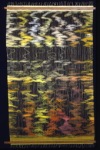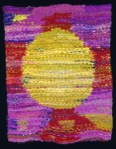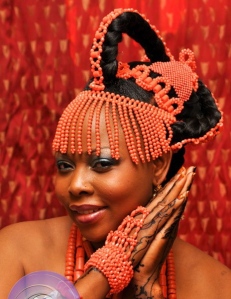MID 20th-Century Textiles From Lenore Tawney and Annabert Yoors
Mid-20th-century textiles, although often dismissed as poor relatives of abstract paintings, are headed for gallery walls and fair booths in quantities not seen since the 1970s. They are coming to light partly because two major weavers, Lenore Tawney and Annabert Yoors, died in the last few years, and historians and dealers have started poring over their archives and surviving works. Ms. Yoors, a Dutch designer who died last year at 83, was the first wife of Jan Yoors, a charismatic Belgian artist. He had escaped from Nazi prisons and lived in Gypsy camps before settling in New York in 1951. The couple collaborated on tapestries up to 20 feet long in bright shard patterns, some based on Himalayan mountain ranges, others on plowshare blades and still others on jungle tree trunks. Here are pictures of some their amazing tapestries Tiapale's as well.
The pictures are courtesy of NY Times, Palm Beach Institute of Contemporary Art.
1. Verdi, 1967. Collage, paper and bone on linen. 11″ x 13″|
2. Jan and Annabert Yoors’s tapestriy.
3. Lenore Tawney’s “Night Bird,” from 1958, combines linen, wool, rayon and silk.
4. Lenore Tawney’s tapestry.
5. Panel Entitled “Yellows”, 1958. Wool, linen, cotton, and silk, plain weave with discontinuous weft open warp areas; knotted warp fringe; feathers 216.7 x 128.2 cm (85 1/4 x 50 1/2 in.).
6. Martha Tiapale. Small Panel, c. 1954. Linen, wool, silk, rayon, cotton, metal-foil laminated in cellulose acetate film-wrapped cotton and rayon, metal-foil laminated in cellulose acetate film, and metal-foil-wrapped cotton, slit tapestry weave 42 x 32.3 cm (16 1/2 x 12 3/4 in.)
Beautiful Coral Beads Of Edo Women – Hair Decor
Edo is the name for the place, people and language of an ethnic group in Nigeria believed to be the descendants of the Benin Empire in modern day Nigeria. Many writers have put the origin of the Edo people as coming from Egypt while others believe the people of Edo originated from Ife, the heatland of Nigeria’s Yoruba.
The photos below show an Edo woman adorned with beautiful beads. Beads worn on the waist are common across Africa, however, beads worn as part of an elaborate hair do are less common. Lagos — The Oba of Bini Kingdom, Omo N’Oba Nedo Uku Akpolokpolo, Oba Erediauwa, recently gave out coral bead, a cherished cultural material in Bini Kingdom to Jackson Gaius-Obaseki in recognition of his service to Bini land.The coral bead called “Ikele” is an important material in Bini Kingdom up of Edo State. It signifies recognition, greatness, hard work to the extent that whosoever wears it is incapable of doing bad. Another significance of the bead is that it is only the Oba that can give it out to those who have achieved greatness not only in the Kingdom, but have made giant strides outside the Bini land.
Photograph Source: Naiaraland.com
Antique Christmas Cards.
The oldest Christmas card created for general distribution probably was created by William Egley Jr.; a 16 year-old British youth. His 3 1/2-inch- by 5 1/2-inch, 1842 printed impression, preserved in the British Museum, depicts four holiday scenes and a “Merry Christmas and Happy New Year” greeting with blanks after the word “To” on the top and “From” at the bottom. The father of American Christmas cards was award-winning Boston lithographer/inventor Louis Prang, who, in 1873, reproduced a holiday card autographed by Christmas Carol author, Charles Dickens.

Perhaps the greatest of Prang’s many innovations was the development of a multi-color printing process that incorporated as many as 20 colors on one print or card. Hues and detailing were so vivid that artists were sometimes not able to distinguish their own works from reproduced chromos (chromolithographic prints) when hung side by side on a wall. Toward enhancing originality, the Boston industrialist began holding Christmas card design contests on a yearly basis beginning in 1880. In 1885, Prang gave prizes for essays on Christmas cards written by women. With prominent judges, lavish celebrations and top prizes from $200 to $2,000, Prang’s contests soon paid off in publicity, becoming media events. Highly collectible Prang cards usually can be identified by tiny lettering “L Prang and Co., Boston” on the bottom margin. Occasionally, Prang left only a rose symbol (a veiled sign of affection for his wife, Rose) or disguised his mark under a tiny shoe or on a leaf.
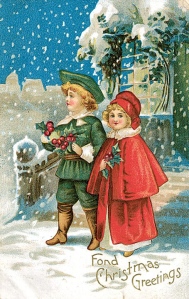
Nineteenth-century Christmas cards are often graphic masterpieces incorporating silk fringes, tassels, mother of pearl inlays and satin backgrounds. Flowers, angels, carolers, gentle animals, romantic young women and happy children are dominant design themes. From 1900 to 1920, penny postcards from Germany featuring Santa Claus, nostalgic hearth and snow scenes, holly, toys and Nativity settings captured the market. In 1910, J.C. Hall began selling postcards out of a shoebox at a YMCA in Kansas City, Mo. His one-man enterprise turned into what we know today as Hallmark Cards Inc. Xmas card collecting (by the way, “X” is not a tacky abbreviation, it has religious significance in that X is the first letter of the Greek word for Christ) can be a rewarding hobby for adults and children. Prominent makers, excellent condition, early age, strong graphics, mechanical movements, interesting “collectible” subject matter, artist signed examples, large size and fine detailing help to determine value. Most of all, look for cards that hit you in the heart. 
Millefiori beads
Millefiori is a glasswork technique which produces distinctive decorative patterns on glassware.
The term millefiori is a combination of the Itallian words “mille” (thousand) and “fiori” (flowers). Apsley Pellatt in his book “Curiosities of Glass Making”) was the first to use the term “millefiori”, which appeared in the Oxford Dictionary in 1849. The beads were called mosaic beads before then. While the use of this technique long precedes the term millefiori, it is now frequently associated with Venetian glassware.
More recently, the millefiori technique has been applied to polymer clays and other materials. Because polymer clay is quite pliable and does not need to be heated and reheated to fuse it, it is much easier to produce millefiori patterns than with glass.
Millefiori paperweight and beads.
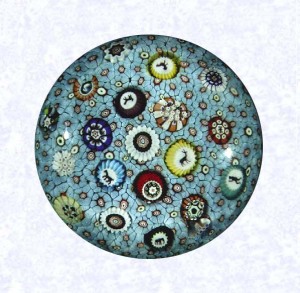

Check this site out for vintage jewelry and home decor
AGEVINT – vintage clothing, jewelry and home decor
History of glass beads
Beads have been made of glass for over 5,000 years. The discovery of fire was the essential step in glass bead making. There is evidence as early as 2340-2180 BC in Mesopotamia of a method known as “core-forming” where they used a metal mandrel with pieces of glass held over a flame. Gradually as the glass soften, they would wrap it around the mandrel forming intricate ornaments. These early beads, or vessels were considered valuable and were preserved as they were placed in burial tombs. In Nuzi (130 miles north of Baghdad) beads were discovered that date to around 1400 BC. Even today, we make beads by holding glass rods over a flame then gently winding the molten glass over the mandrels. The invention of the blow pipe in gave way to the creation of the Rosetta bead and the seed beads which sustained the bead making industry in Venice for centuries. Bead making is truly an ancient art form.

Turquoise Beads From Ancient Egypt
Archaeologists excavated the oldest Turquoise Jewelry known in the world at the cemetery of the royal tombs at Abydos? Turquoise bracelets in gold setting were among other items, found there and are now shown in the Cairo Museum. They are from approximately 5500 B.C.The Egyptians adored turquoise. Some of beads made by the Egyptians these date back to 5500 B.C. Barrel beads and roundel beads are among other types of beads made by the Egyptians. These beads were mixed with obsidian, moss agate and glass beads.

Gold and silver coins are going high at antique auctions.
Demand for silver dollars remained strong, with a high grade set of 24 Peace Dollars, from 1921-1935 leading the way at $2,090. Two other silver dollar sets made a strong showing, with 20 1922 Peace Dollars, with mixed mint marks sold for $677; and 20 1921 Morgan Dollars, again with mixed mint marks, earned $742.
As at most coin auctions these days, gold was once again king, with a 1900 $20 Double Eagle gold coin selling for $1,815, with a 1904S $20 Double Eagle gold coin following closely at $1,787.
In other coinage, a Washington quarter set, dated 1932-1998, sold for $1,320; 200 Roosevelt silver dimes, $660; 29 1964 Kennedy Halves, UNC/BU, brought $341; and seven U.S. proof sets, 1954-1960, in a plastic case brought $577. Five 2-cent pieces, four of them dated 1864 and one dated 1865, also brought $730.
Paper currency included a $10 Gold Certificate 1928 series, rated very fine or better, brought $231; and two U.S. National Currency $1 large notes, comprised of a National 1914 series and a U.S. 1917 series, sold for $154.



